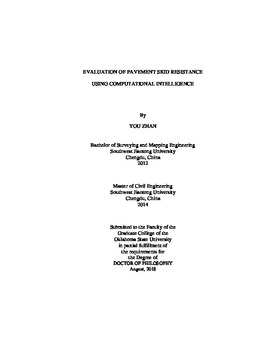| dc.contributor.advisor | Li, Qiang | |
| dc.contributor.author | Zhan, You | |
| dc.date.accessioned | 2019-03-20T19:25:40Z | |
| dc.date.available | 2019-03-20T19:25:40Z | |
| dc.date.issued | 2018-08 | |
| dc.identifier.uri | https://hdl.handle.net/11244/317650 | |
| dc.description.abstract | Pavement micro-texture is affected by the aggregate characteristics contained within the surface. It is long desired to develop friction prediction models using pavement surface and aggregate textural properties. However, the development of such models has proven to be challenging because of two reasons: (1) The acquiring of complete and high quality pavement surface data for friction studies remains difficult. (2) No consistent and reliable methodologies and models have been developed for friction prediction and evaluation. | |
| dc.description.abstract | The objective of this dissertation is to investigate the most influencing factors for pavement skid resistance, and develop reliable and consistent friction prediction models based on aggregate physical properties and pavement surface texture characteristics from three perspectives. The state-of-the-art 3D laser imaging technology, high speed texture profiler, and the continuous friction measurement equipment (CFME) - Grip Tester, are used in parallel in the field to collect 1-mm 3D pavement surface data, macro-texture profiles and pavement friction data respectively at highway speed for selected testing locations, while the newly developed portable ultra-high resolution 3D texture scanner (LS-40) is utilized in the laboratory to acquire both macro- and micro-texture characteristics of pavement surfaces, and the Aggregate Image Measurement System (AIMS) to analyze surface characteristics of aggregates before and after the Micro-Deval polishing process. | |
| dc.description.abstract | Firstly, this study predicts pavement friction as a function of pavement surface and aggregate texture properties. Secondly, panel data analysis (PDA), which is able to investigate the differences of cross-sectional information, but also the time-series changes over time, is conducted to evaluate pavement skid resistance performance and identify the most influencing factors. Finally, inspired by the big success of deep learning in the field of image recognition and computer vision, a novel Deep Residual Network (ResNets) tailored for pavement friction prediction, named Friction-ResNets, is developed using pavement surface texture profiles as the inputs. | |
| dc.description.abstract | This dissertation developed several novel friction prediction models that could assist in selecting the most effective PM treatments, and proper aggregates with desired texture characteristics for optimized skid resistance. This study also demonstrates the feasibility of replacing the contact based method for pavement friction evaluation with non-contact texture measurements. | |
| dc.format | application/pdf | |
| dc.language | en_US | |
| dc.rights | Copyright is held by the author who has granted the Oklahoma State University Library the non-exclusive right to share this material in its institutional repository. Contact Digital Library Services at lib-dls@okstate.edu or 405-744-9161 for the permission policy on the use, reproduction or distribution of this material. | |
| dc.title | Evaluation of pavement skid resistance using computational intelligence | |
| dc.contributor.committeeMember | Wang, Kelvin C. P. | |
| dc.contributor.committeeMember | Cross, Stephen A. | |
| dc.contributor.committeeMember | Good, J. K. | |
| osu.filename | Zhan_okstate_0664D_15848.pdf | |
| osu.accesstype | Open Access | |
| dc.type.genre | Dissertation | |
| dc.type.material | Text | |
| thesis.degree.discipline | Civil Engineering | |
| thesis.degree.grantor | Oklahoma State University | |
